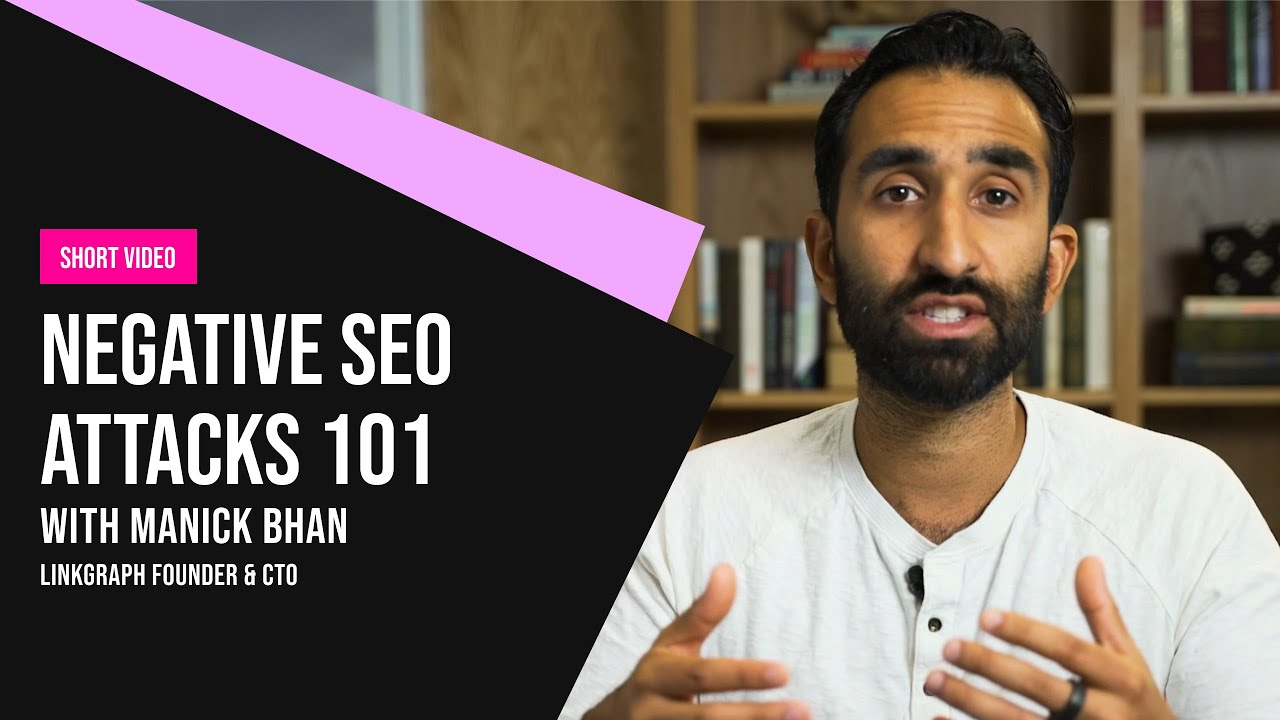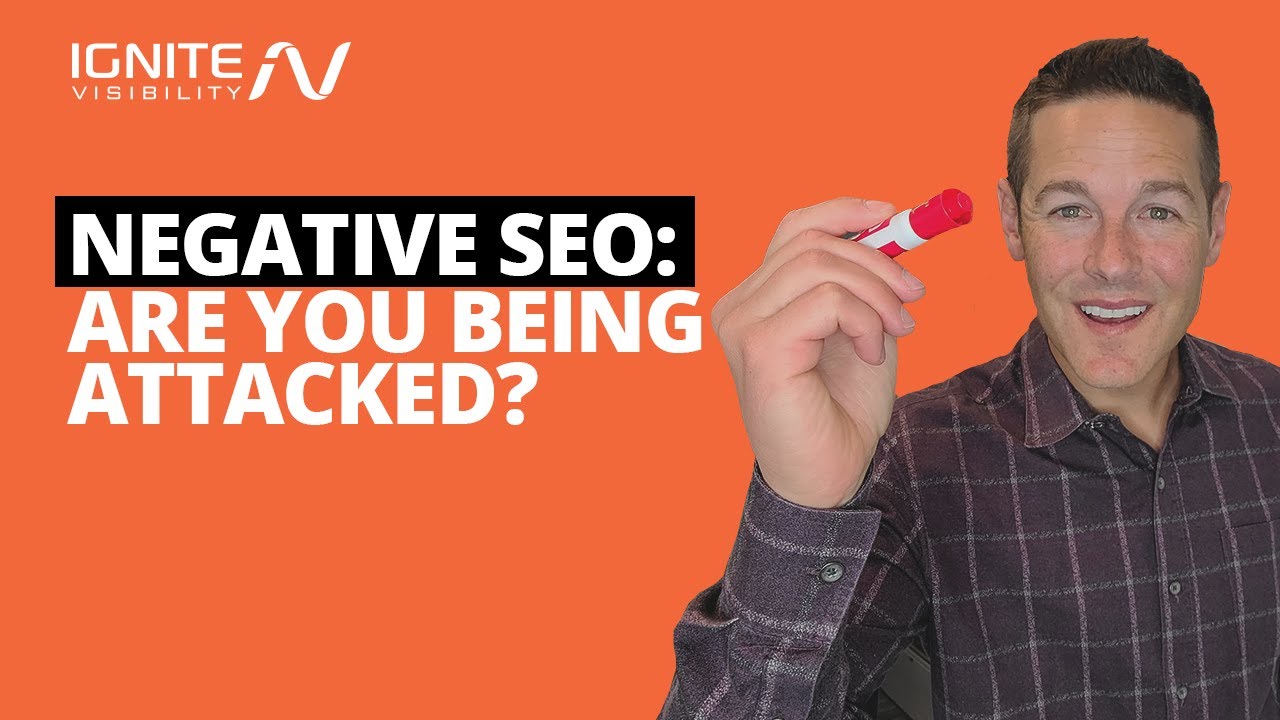The risk of negative SEOis small but still scary. How easy is it for a competitor to hurt your site's rankings, and what can you do to protect it? But before we get started, let's make sure everyone knows what negative SEOis and what it is not.
Negative SEOis a set of things that are done to bring down the rankings of a competitor in search results. Most of the time, these things happen outside of the site (like building links to it that don't make sense or scraping and re-posting its content), but sometimes they involve hacking the site and changing its content.
The most likely reason for a sudden drop in rankings is not negative SEO. Before you think someone is trying to hurt your rankings on purpose, you should look at the more common reasons why rankings drop.
What Is Negative SEO?

Negative SEO
Standard search engine optimization, as you probably already know, is about improving a domain's authority and search ranking. Some of the ways to do this are by making content, researching keywords, marketing on social media, and building backlinks.
If done right, the targeted domain will get higher SERPrankings, more traffic, higher conversion rates, and better brand recognition.
Negative SEO is the exact opposite of this. It is a set of tricks and plans that are meant to hurt a domain or company's ranking, authority, and brand reputation.
Most of the time, the domain in question belongs to a competitor. However, there are some "black hat" service providers who will do negative SEO attacks for a fee.
Origins Of Negative SEO
When figuring out the authority of a web page, Google has always done its best to find links that don't make sense. At first, spammy links were just ignored because they didn't pass any link juice.
And SEOs used the system to their advantage by building and buying thousands or even millions of backlinks. Those who passed the test helped the site's ranking, while those who didn't just didn't, which didn't hurt the site.
In April 2012, Google released the Penguin update. This was the first time they would punish sites with manipulative links in a strong way. It meant that you could no longer rank your website by using links of low quality.
At the same time, it meant that you could buy low-quality links for your competitor's website and get Google to punish it. Then negative SEO really took off.
What does Google have to say about it? They do admit that sometimes bad SEO attacks happen, but not very often.
Keep in mind that Google has said many times that negative SEO is unlikely to work and that it happens very rarely. As their algorithms get smarter, you're even less likely to have this happen. Unfortunately, it's still not completely impossible.
Is Google Doing Anything About Negative SEO?
Google does a lot of work behind the scenes, but they can't say exactly what happens in each update because spammers would figure out ways to take advantage of the new algorithms right away.
Google's public response to worries about Negative SEO was the "link disavow" feature, which was released in October 2012. This webmaster tool lets webmasters know when there is manual spam or links that don't make sense.
It also gives webmasters the option to stop backlinks from linking to their site and/or domain. Google makes it easier to keep an eye on fraudulent activity by dealing with the problem at its source. This is done with a simple text file of URL listings.
Why Would Anyone Commit A Negative SEO Attack?
Like hackers, people who do Negative SEO attacks may have different reasons for doing so. It can be done on purpose like to ruin a competitor's website, to get money, or just for fun. Don't be surprised that you can easily find a lot of these Negative SEO Services online.
Believe it or not, a Negative SEO attack can also happen by accident. In some cases, family members, employees, or even SEO companies hired by the website owner do out-of-date "Black Hat" practices on purpose because they think it will help their website rank.
5 Types Of Negative SEO Attacks

Negative SEO Attacks | Digital Marketing 101
Link Farms
No matter how many good links you had before, a single spammy link (even if it's sitewide) shouldn't be able to ruin your site's rankings. Because of this, negative SEO often uses links from a group of sites or "link farms."
A link farm is a group of websites that all link to each other. These sites used to link to each other to boost the link popularity of each other's pages. This used to be a Grey Hat technique, but now it's almost always Black Hat.
You could buy links from these sites to boost the PageRank of your own site. A PBN, or private blog network, is an example of a link farm. These are sites that were made just for building links.
Most PBNs are made up of expired domains, which means that the sites usually already have some backlinks and authority when they join a PBN.
Google's Penguin algorithm, which was released in 2012, made it much harder for link farms to work. If Google sees backlinks from a link farm, it might think that the site being linked to is part of a link scheme, which will result in a penalty. So, link farming went from being a black-hat SEO technique to a bad one:
Scrapers
Duplicate content that has been changed is another bad SEO technique. It involves taking the content from your site and putting it on other sites, often more than once, and sometimes even as part of the link farms we talked about above.
You probably already know that Google's Panda update was partly made to find and stop duplicate content. So, when Google finds the same content on more than one site, they will usually only rank one of them.
You'd hope that Google is smart enough to figure out where the content came from, and most of the time, they are. Unless the copy that was scraped gets indexed first.
Because of this, scrapers often copy new content automatically and put it back up right away. If Google finds the "stolen" version first, it might drop your site in the rankings and move the scraper site up.
How to stay safe: You can stay safe from scrapers with a few great tools. One of them is Copyscape. To find out if your content is already online somewhere else, all you have to do is type in the URL. If you find scraped copies of your content, it's best to contact the webmaster and ask them to take the piece down, even if you don't think they'll listen. If that doesn't work, you might want to use Google's copyright infringement report to report the scraper.
Fake Reviews
Good reviews are just as important as good links. If you get a lot of bad ones, it hurts your local search enginerankings and hurts your business. But reviews are easy to change, and a competitor who wants to get ahead might try to do that first.
How to stay safe: Obviously, you should keep an eye on your Google My Business listing and read any new reviews that come in for your business. Google's policy says that you shouldn't "post reviews for other people or lie about your identity or connection to the place you're reviewing." This means that fake reviews are against Google's policy.
Heavy Crawling
A desperate competitor might try to crash your site if they don't know any better. This Black Hat SEOtrick is done by crawling the site by force, which makes the server work hard.
This could slow the site down or even cause it to crash. And if it happens more than once, search engines may start to think less of you.
How to stay safe: If you notice that your site is getting slower or, worse, crashing, you should contact your hosting company or webmaster. They should be able to tell you if the extra load is due to maintenance, natural traffic, or an attack on your website. They will also have a number of solutions, such as adding firewall rules or rerouting traffic through a DDoS protection service.
Hacking And Malware
After a hacking attack, your website's ranking can get messed up. Low-quality or duplicate content could be put on your website, your links could be changed, new links could be added, and your robots.txt file could be changed to mess with crawling. Aside from that.
How to stay safe: The best way to keep your site safe from these kinds of threats is to do regular site audits with a tool like WebSite Auditor. Start WebSite Auditor and make a project for your site to run an audit. Use the Rebuild Project button to run it again for a project that has already been made. If you do this often, you should be able to notice small changes that you might not have seen otherwise.
Secure Your Website Against Negative SEO Attacks

Negative SEO: Are You Being Attacked?
The first step in dealing with negative SEO is to know when you've been attacked.
Signs like these can give the game away:
- Sudden unexplained drops in web traffic.
- Sudden spikes or decreases in your backlink catalog.
- Drops in your rankings for specific keywords.
- Warning messages from Google about your web practices.
- Many copies of your content show up around the web.
Here are some things to think about when dealing with a possible attack, getting back on your feet after one, and making sure that negative SEO doesn't hurt you again in the future.
Fortify Your Site Against Hacks
When a negative SEO expert actually hacks into your site to change its code, it can take a while for you to realize that something is wrong. But doing regular site audits can help you find any problems early, before they can hurt your SEO.
You can also set up Google Search Consoleto let you know if there are any problems with your site's indexing or security. Make sure you take care of your safety by using strong passwords, antivirus software, and two-factor authentication.
Maintain Your Backlink Catalog
If you haven't been keeping track of your list of backlinks yet, it's time to start. Choose a tool that takes the guesswork out of the process and check it often to make sure everything is working as it should. You'll find out right away if you lose good links or get bad ones.
And if you find that your list of backlinks suddenly has a lot of bad ones that need fixing, send Google Webmaster Tools a file with all of them in it. This tells Google that those links shouldn't be taken into account when figuring out where you stand.
Take Steps To Protect Your Content
Using a reliable tool like Copyscape is the best way to find out if any of your site's content has been copied. If you find duplicate content, send an email to the website owner and ask that it be taken down.
When you reach out, be sure to copy an appropriate legal party so they know you mean business. If a whole website looks just like yours, tell Google right away and ask them to take it down.
Use canonical tags to make sure Google knows you are the original author of your site's best content. For good measure, add a copyright notice and updated Terms of Service to your site that make it clear your content can't be copied or shared again.
Report Fake Social Profiles
If you find fake social media profiles using your company's name, report them right away, before they get followers and hurt your efforts to build your company's reputation.
There are also tools that can help you keep track of when people talk about you on social media. Check your mentions right away to find out if someone is using your company's name or spreading false information.
This is a good thing to do anyway because it helps you connect with people who are genuinely talking about your brand.
Keep Track Of Your Reviews
You should already be keeping an eye on your reviews, just like you do with your social mentions and backlinks. Again, the key to stopping a negative SEO campaignin its tracks before it can ruin all your hard work is to catch it early.
If you find negative reviews of your products, brand, or company from people who say they know you but don't, report them to Google and the platform where they were posted. And, of course, you should always try to make things right when real people give you bad reviews.
Enable Email Notification Google Search Console
Enable email notification Google's search engine tool. Now you can keep all the information and problems about your website in the front of your mind. Once you know what's going on, you can use more advanced techniques to stop negative SEO.
For example, you can keep an eye on your website's backlinks, disavow (or get rid of) suspicious backlinks, and protect your website from malware and hackers.
Watch out for people who steal other people's work. Copyscape and Grammarly can help you find other copies of your content on the Internet if there are any. They can also help you improve the writing on your site and keep you from accidentally plagiarizing.
Keep An Eye On Your Social Media Mentions
Use your social page dashboards to get involved in how social media is run. HubSpot, Hootsuite, and Social Mention all have tools for social listeningthat let you know when your name comes up on social media. When you are talked about, make sure to address any concerns directly and quickly so that bad news doesn't spread.
Speed Up Your Website Loading Time
Google AnalyticsAlerts will let you know when and why your website is taking longer to load by sending you an email. You may need to turn on caching, remove plugins or add-ons that use too many resources, change the sizes of your images, get rid of extra code, or take other steps to stop spammers from using your site.
People Also Ask
Is Negative SEO Real?
Yes, without a doubt. Negative SEO is a real problem that many sites have had to deal with. It's much easier to stop it from happening than to fix it. If you search "negative SEO" on Fiverr, you will find more than 15,000 people who are willing to do the work for $5.
Is Negative SEO Illegal?
Negative SEO is not illegal, but it is very unethical, and Google will not put up with it. As a result, it is best practice for webmasters to protect their website from negative SEO attacks so that they don't get unfair penalties.
How Do You Detect And Deflect Negative SEO Attacks?
Keeping track of your backlinks is one of the easiest ways to spot and stop SEO attacks that aren't good for your site. Most of the time, people who want to hurt your website with negative SEO will link it to low-quality backlinks, which will cause your website's rank to drop from where it is now.
Conclusion
As you can see, the best way to avoid negative SEO is to use good security practices, keep an eye on your site's analytics, and keep track of links and social signals from all over the web.
Then you should act right away, before the person's actions can do any damage. Even though a negative SEO attack can be annoying, it means that your business is doing something right and making waves in its field.
But if you are always on the lookout and do regular audits and other similar things, it will be hard for anyone to stop your progress. By making content optimizationpart of your ongoing SEO strategy, you can improve your search engine rankings and make your content even better.
